In case you’re shopping for vegetation for shade, firstly take into consideration what sort of shade you might have in your backyard.
A minimum of half your backyard – wherever you reside – is shady. In case you’re in a city or metropolis, with a small backyard surrounded by tall buildings, then a lot of your backyard could also be shady for a lot of the day. However there are such a lot of stunning vegetation that can do effectively in these situations!
So I’ve requested prime plant professional, Stephen Ryan, who runs the Horti-Culturalists YouTube channel close to Melbourne in Australia together with his gardening associate, Matthew Lucas for his or her tips about selecting vegetation for shade.
Melbourne’s local weather is much like that of the UK in winter, though hotter in summer time. Just like the UK, Melbourne roughly equates to a US hardiness zone of 9 – though UK summers are cooler. And whether or not you’re within the UK, the US or Southern Australia, all of us develop lots of the identical vegetation.
And their autumn is our spring. So the Horti-Culturalists’s video will select some good late summer time/autumn vegetation for shade, whereas the Middlesized Backyard’s video talks about shade-loving vegetation for spring and early summer time.
What sort of shade do you might have?
Stephen recognized 4 completely different sorts of shady border. I’ve all 4 in my backyard. You in all probability do, too.
And shady borders may be surprisingly low upkeep, in addition to fairly.
Firstly, there may be the apparent ‘shady border’. It will likely be north-facing within the Northern hemisphere and south-facing within the Southern hemisphere. It would at all times be in shade for a lot of the day, as a result of the fence or hedge behind it’ll forged shade. If it’s pretty open, then there’ll be as much as round three hours at noon when it’ll get direct solar. However in case you have timber or buildings close to it, then even that could be minimize quick.
When selecting vegetation for this border, concentrate on how a lot direct solar it will get. My shady nook has unusually excessive partitions, so, though it’s open it doesn’t get greater than the three hours direct solar a day.
When a border faces North (or south within the Southern hemisphere) and has a wall, fence or hedge behind it, vegetation will solely get round sunshine for round 3 hours a day, when the solar is comparatively overhead.
One of the fashionable posts we revealed within the final yr was this one on North-facing backyard suggestions, particularly because the backyard itself was additionally very slim. But it surely reveals you the way you don’t want numerous area and solar to have a gorgeous backyard.
And there’s dappled shade, semi-shade and light-weight shade
These phrases all imply a lot the identical factor. You get three to 6 hours of direct solar in your border every day. This can be as a result of the border faces East or West, or there are timber or buildings that partially obscure the sunshine at sure instances of day.
I’ve a gorgeous tree rising in a sunny nook of my backyard. It throws dappled shade over the border, however some sunshine comes by way of. This tree – a Robinia frisia – has a fantastic presence within the backyard and it’s protected by regulation.
So I’m not allowed to chop it down, nor would I want to. Nevertheless, I’ve elevated the quantity of sunshine out there to vegetation under by taking away a few of the decrease branches. The tree is completely proportioned and its cover can be fairly mild.

Any space that will get 3-6 hours solar a day has partial shade, dappled shade or semi-shade. I made this nook extra sunny by eradicating the decrease branches of the tree.
When selecting vegetation for mild shade, you might have extra choices. It could possibly even be value experimenting with vegetation that require ‘full solar’ to see how they develop with you, though in the event that they get leggy or by no means appear to get going correctly, you’ll have to maneuver them.

Smyrnium perfoliatum is one in every of my favorite vegetation for shade in my partial shade border, flowering in late spring and early summer time, then disappearing after that. It’s a biennial so it doesn’t flower its first yr, but it surely self seeds prolifically, so it’s straightforward to develop.
Or seasonal shade
When you have deciduous timber in your border, they are going to lose their leaves in autumn. They typically received’t be absolutely ‘clothed’ once more till late spring or early summer time. So this might be a shady border in summer time however sunny in spring.
This implies that you would be able to decide sun-loving spring vegetation, similar to tulips, daffodils and different bulbs. By the point the border is absolutely shady once more, they are going to have saved the vitamins they want for flowers subsequent yr.
My favorite a part of my backyard in spring is between a silver birch a cotinus, an amelanchier and a decorative plum. All lose their leaves in winter, so this space is a riot of bulb color in spring.

This space is good for bulbs in spring. They go underground in summer time, when the leaves are on the timber and it’s shady.
You may surprise why I don’t minimize these timber down, so I might have this as a sunny border all yr spherical?
Firstly, the most important – the silver birch – is protected by regulation. However, secondly, they add peak, proportion and architectural curiosity to the backyard. The amelanchier and decorative plum have beautiful blossom in spring and all 4 timber have excellent autumn color. And the white bark of the silver birch is a key winter assertion within the backyard.

Spring blossom on the Amelanchier lamarkii (Juneberry, Serviceberry), with the bulbs beneath that develop effectively on this spot despite the fact that it’s shady in summer time.

Only a small style of the autumn color the 4 timber give the backyard on the finish of the season.
They add extra color and drama to the backyard all year long as timber than a low-growing flower mattress would.
Actually, in case you have a north-facing border with a 2 metre hedge or fence, then the best method so as to add color and construction is commonly so as to add a deciduous tree with spring blossom and autumn color. As soon as the tree is increased than the fence or hedge, it’ll get all spherical solar.
And eventually – borders with deep shade
In case you’re shopping for vegetation for shade, that is the one actually tough a part of your backyard. This border might be north-facing (within the Northern hemisphere, south-facing in Australia/New Zealand). However it’ll even have buildings or evergreen timber close by (or each!) so it will get little or no direct solar.
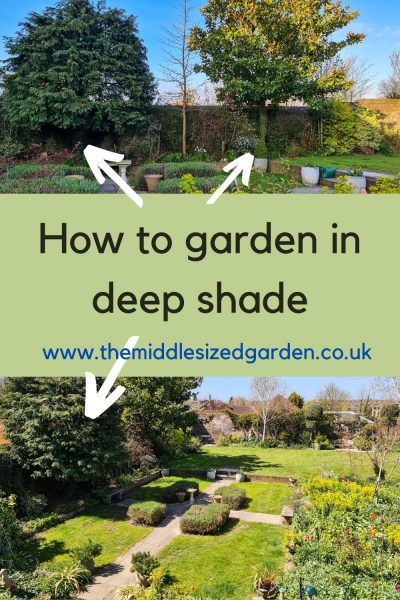
When you have a shady border plus evergreen timber, there might be small patches the place little or no will develop. However these evergreen timber add year-round construction to the backyard, provide shelter to wildlife and display us from an unpleasant road lamp. So I can dwell with just a few naked patches beneath them!
There’s a very restricted palette of vegetation that may cope with deep shade, says Stephen. Butcher’s-room (Ruscus aculeatus) is without doubt one of the few. It has spiky leaves, small pale inexperienced flowers in spring and pink berries in autumn (on feminine vegetation solely, so verify).
You may adapt planting recommendation from woodland gardens. I not too long ago spoke to Lucy Adams, head gardener at Doddington Place Gardens about create a woodland backyard. One good tip is to plant on the sting of the tree’s cover, as a result of that can get way more solar.

Crops develop effectively just below the sting of the timber’ cover in my backyard. You’ll nonetheless have to decide on vegetation for shade, however you’ll have a sensible choice.
It’s massively useful to see if weeds develop in your space of deep shade. I’ve a north-facing border, which is within the shade of the subsequent door constructing and likewise has two evergreen timber. Not even weeds develop immediately below the conifer, though on the fringe of its cover I can develop snowdrops, ivy and a fern.
If weeds received’t develop there, then there’s not a lot probability of flowers doing effectively. You possibly can strive rising pots elsewhere and transferring them into the deep shade when in flower, however that could be a faff. It’s in all probability higher to make use of the area for one thing else, similar to a shady seating space or bench.
The opposite tree on my shady border is an evergreen magnolia. However vegetation do appear to develop below that and on its cover edge. Its cover is increased, as we eliminated some decrease branches, so that allow’s in a bit of extra mild.
There’s an Osmanthus delavyi, some saxifrage ‘London Pleasure’, lily of the valley, two hydrangeas and a considerably unattractive wild strawberry.

Hydrangea arborescens ‘Annabelle’ grows proper up in opposition to the conifer in my most shady border. Nevertheless nothing grows immediately below the conifer.
Take into consideration seasonal curiosity
When you’ve recognized the kind of shade you’re planting up, take into consideration seasonal curiosity. You desire a unfold of vegetation that look good in spring, summer time, autumn and even winter. Many on-line plant sellers may have a ‘vegetation for shade’ choice on their web sites, so it’s comparatively straightforward to search out vegetation.
To present you inspiration, I’ll begin off with a few of the shade-loving vegetation which were most profitable for me within the first half of the season. Stephen and Matthew will recommend some late summer time/autumn vegetation over on The Horti-Culturalists.
Crops for shade in late winter/early spring
Snowdrops develop very effectively below deciduous timber. They’re woodland bulbs, in order that they’re a pure for rising below timber which lose their leaves in winter and likewise for cover fringe of evergreen timber.
When it comes to deciduous shrubs, then winter hazel (Corylopsis pauciflora) has delicate yellow flowers.
And mahonia is a superb giant evergreen shrub with a sculptural define and brilliant yellow flowers. It could possibly take fairly deep shade. Mahonia has fallen out of favour over the previous few many years as a result of it’s a favorite of city automotive parks, the place it will get butchered by individuals with chain saws. However correctly pruned (and even simply left to itself), it has superbly darkish shiny leaves and a showy show of flowers. Overdue for a revival.

Mahonia, with its sculptural leaves and brilliant yellow flowers, seen right here within the woodland backyard at Doddington Place Gardens. An easy, hanging shrub for shady borders.
In case you’re on the lookout for good shade-loving spring perennials, Bergenia is the simplest plant I’ve ever grown. I very hardly ever pay it any consideration. But it reliably flowers yearly for weeks, in clumps beside partitions, below deciduous timber and in uncared for corners.
And what would spring be with out hellebores? Individuals can change into obsessive about hellebores, however they’re nonetheless very easy-care. I’ve some on the cover fringe of my deep shade border, plus some extra within the partial shade mattress. They’re very resilient for such delicate-looking vegetation.

Hellebores are easy-care vegetation for shade.
Perennial vegetation for shade in late spring and early summer time
There are such a lot of selections! Mediterranean spurge of (Euphorbia characias ‘Wulfenii’) is a star within the shadier components of my backyard all through spring. It spreads, however isn’t too invasive, so I discover it very straightforward care.
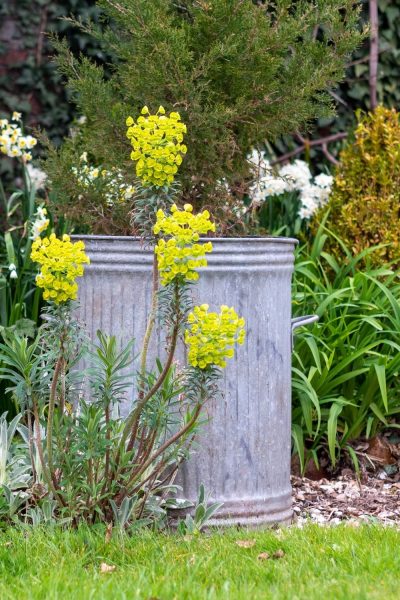
Euphorbia ‘Wulfenii’ is a straightforward going perennial which grows simply in any of my shady borders.
For a very fairly floor cowl perennial, I’d select Saxifrage ‘London Pleasure’, which grows on my deep shade border, in a ‘woodland edge’ place below the cover of my evergreen Magnolia Grandiflora. The one factor to recollect is that Magnolia grandiflora has huge, leathery leaves which drop in ones and twos all yr spherical. In the event that they land on floor cowl vegetation like Saxifrage ‘London Pleasure’ for too lengthy, they are going to smother them, so scoop up the leaves infrequently.
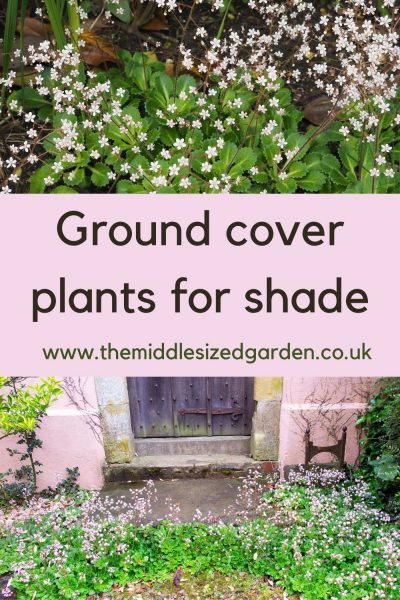
A gently fairly floor cowl plant – Saxifrage ‘London Pleasure’. It goes effectively with Geranium Macrorrhizum, which is one other good plant for shade.
One other good floor cowl perennial is Yellow Lamium, though some individuals discover it invasive and regarded it as a weed. It’s also called Yellow Archangel or Yellow Weasel-face. Primroses, too, will fortunately thrive in some pretty gloomy spots.
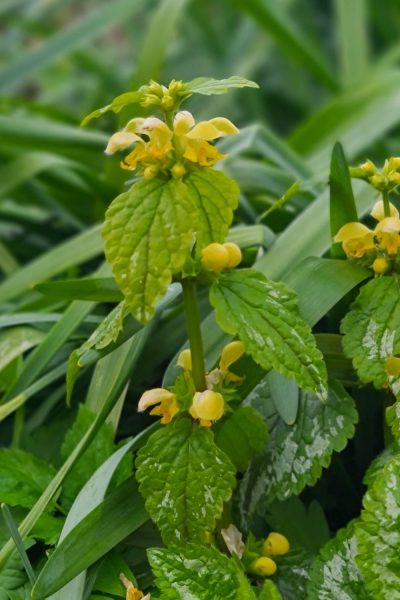
Yelllow Lamium will develop the place virtually nothing else will – though it may be invasive. An excessive amount of of an excellent factor?
Annuals, biennials and shrubs for shade
Euphorbia oblongata or spurge self-seeds itself in my shady border, and has brilliant, contemporary inexperienced flowers and foliage all through early spring and summer time.
Perfoliate Alexanders (Smyrnium perfoliatum) seems to be fairly related however is extra distinctive – each time I publish an image of it on my Instagram feed, I get queries as to what it’s. Smyrnium perfoliatum is a biennial and it self-seeds vigorously. I’ve it within the dappled shade border and likewise the seasonal shade border.
For floor cowl, violas are good shade-loving annuals, which self-seed vigorously.
Considered one of my favorite shade-loving shrubs is Viburnum opulus or Snowball bush. It has white pom-pom flowers in spring and a few varieties even have pink berries. Mine doesn’t – it’s sterile, so verify that on the label before you purchase. But it surely does have magnificent autumn leaf color.

Viburnum opulus has stunning white pom-poms in spring and lovely autumn color.
I additionally like Osmanthus delavyi, which is a darkish evergreen shrub which is flowering its socks off immediately beneath the evergreen Magnolia Grandiflora. It’s very sluggish rising and has taken about ten years to get to that measurement but it surely’s undoubtedly value interested by.
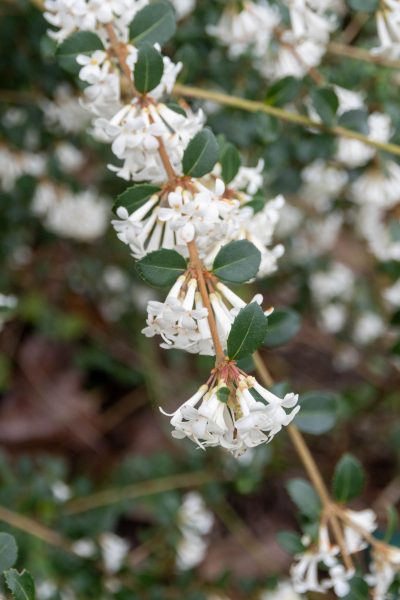
Osmanthus delavayi is a sluggish rising darkish inexperienced shrub with stunning white flowers. Mine has grown effectively in fairly deep shade.
Vibrant flowers for shade
Begonias are an incredible species. Like many actually versatile vegetation, they are often neglected as a result of you may see them in grocery store automotive parks and in municipal preparations. However you should purchase a variety of flower varieties and hues, and a few even have great leaf construction.
Begonias do effectively in pots and in borders in filtered mild. They actually do want to be in at the very least partial shade. They received’t flower in deep shade, but when there’s 3-4 solar a day, they’ll be joyful and so they’re high quality in dappled shade.
And begonias begin flowering pretty early on in the summertime, relying on their kind. And so they go on and on and on.

Begonias (prime) and Busy Lizzies. Begonias are available an enormous vary of colors and now have some dramatic foliage.
Impatiens, or Busy Lizzies, additionally develop effectively in related situations. They virtually disappeared from the market just a few years in the past as they have been affected by a illness, however illness resistant varieties at the moment are out there.
Good late summer time and autumn vegetation for shade
Stephen and Matthew will inform you extra about what you should know on this video on their Horti-Culturalists channel:
Store my favorite gardening books, instruments and merchandise
I’m typically requested for suggestions, so I’ve put lists of the gardening books, instruments and merchandise I take advantage of on the Middlesized Backyard Amazon Retailer. Observe that hyperlinks to Amazon are affiliate, see disclosure.
For instance, there’s a listing of books on gardening within the shade and vegetation for shade.
You too can purchase mugs, t-shirts and an natural tote bag with my favorite saying ‘Gardeners Study By Trowel and Error’ right here. These assist to help this weblog and YouTube channel, so if you’re , thanks for checking it out.
Pin to recollect vegetation for shade
And do be a part of us – for a free weekly e mail with extra gardening suggestions, concepts and inspiration, see right here.

